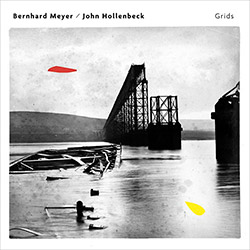
In Grids, drummer John Hollenbeck and bassist Bernhard Meyer combine to form their first collaborative project. Although commonly referred to as a jazz drummer, Hollenbeck often refers to his domain of music as "post-jazz", which incorporates elements of musical impressionism, ambience and minimalism. As such, Grids isn't so much a jazz project; musically, it is too amorphous to place into a genre. The project, rather, is a tonal, textural and emotional experiment. This multifaceted sonic exploration of the record is paralleled with a geographic journey.
This joint venture commences with "Black Rock Desert", where Hollenbeck's free form brush instrumentation provides a subtle yet intransigent rubric for Meyer's sprawling, reverb-laden chromatic scales to flourish in. A Hollenbeck polyrhythmic morass marks the descent into the next track, "Peace-Athabasca". Meyer's assertive and dissonant chords stand in stark contrast with the serene beauty of the Canadian town that the song borrows its name from, and rhythms metastasize and coalesce as Hollenbeck's drumming begins to take dominion over Meyer's noise, which fades out into reverberated, prolonged cries.
In "Kozhim, Narada, and Balbanyu", there is a descent into ambience. The allusion to Russian rivers in the title of this song is apt: just as a river's flow and flux is stifled by its banks, Meyer's impressionistic, free-flowing bass crawls like a miasma while Hollenbeck's jangly, percussive wall provides a semblance of structure and orthodoxy. "Vya" provides another plunge into the ambient, where space and minimalism take primacy. Wispy drum notes intertwine and become enmeshed with Meyer's scales. Ethereal swathes of harmony run through the sparse track, just as the gentle breeze would tousle the Nevadan town.
"Xina Bena Jord„o" and '"ydraotes Chaos" provide two different experiences while, largely, using the same rhythmic foundation. The latter revokes the fleeting moment of sonic solace provided to the listener in "Kozhim, Narada, and Balbanyu". "Hydraotes Chaos" provides a sonic account of 'chaos terrain.' Efflorescent and volcanic drums sway in an out of coherence, darting to and fro. The former alludes to the indigenous Huni Kuin tribe of the Amazon, where Meyer's harmonic bass interjections compliment the fervid, trance-inducing, percussive instrumentation.
"105, Sangkat Boeung Prolit, Khan 7" places the listener into a dissonant quagmire. Percussive slams and clatters vie against the sole source of rhythm and structure within the track, an incessant prepared piano. In "Uluru-Kata Djuta", this sentiment is continued. Elongated and prolonged scales recline over arrhythmic flurries, belying the harmony of the location that the song takes its name from.
At some points this tonal, textural and emotional experiment that is presented to the listener has the feel of a particularly boisterous roller-coaster. The sonic landscapes that are painted are unfamiliar and intrepid. However, this comparison is not a pejorative one, for Grids also implores the listener to raise their arms, as if they were riding the roller-coaster, and jubilantly accept the unfamiliar. If one does roll-with-the-punches, and accepts the route of the roller-coaster, then Grids is as thrilling as one.
Comments and Feedback:
|



